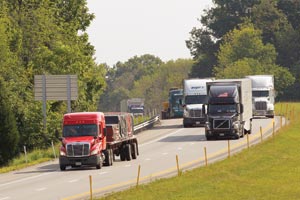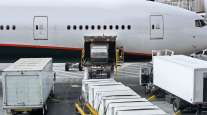Truckload Rate Growth Eases as Freight Demand Sputters

The recent strong growth in rates is slowing as freight demand wanes and capacity loosens, industry statistics show.
The trend reflects a freight market characterized in fleets’ comments about third-quarter earnings with words such as “soft” and “lackluster.” The shift also was illustrated last week when the Commerce Department reported gross domestic product rose at just a 1.5% annual pace in the third quarter, far slower than the 3.9% second-quarter rate.
From a broad perspective, Cass Information Systems’ index of truckload rates based on freight payment data, rose just 3.2% in September above the same month last year, the smallest increase since early 2014. In September 2014, the rate increase was 6.7% over the prior year.
Rates on a per-mile basis excluding fuel surcharge rose at a slower pace at most fleets last quarter, compared with the second quarter of this year and last year’s third quarter. For example, Swift Transportation Co.’s truckload rates were 3.6% higher in the third quarter than a year ago, compared with 4.9% in the second quarter and 5.1% in last year’s third quarter.
Knight Transportation, which ranks No. 31 on the Transport Topics Top 100 list of the largest U.S. and Canadian for-hire carriers, raised rates 4.6% last quarter, less than 6.7% in the second quarter and 6.5% in the 2014 third quarter. No. 16 Werner Enterprises’ increases were 2.8% in the third quarter, 3.8% in the second quarter and 5.1% in the July-September period of 2014.
“Excess capacity during the quarter put downward pressure on noncontractual pricing across all of our segments, particularly spot market [truckload] pricing and certain [less-than-truckload] pricing,” said Roadrunner Transportation Systems, which blamed the weak conditions in part for third-quarter earnings that are expected to be as much as 70% below the average analyst forecast.
Spot rates for all types of truckload freight this year have lagged 2014, when weather and other disruptions pushed spot rates to record levels.
Jason Seidl of Cowen and Co. said previous expectations of 4% to 5% rate increases excluding fuel surcharges have been knocked down by lower demand in the weak spot market.
“Carriers do not appear to expect much in the way of contractual rate increases in the remainder of the year and 2016,” he said.
Mark Montague, an analyst at DAT Solutions, told TT “the momentum is coming out of contract rates,” after a 4.7% increase last year.
“We think shippers are going to hold the line on increases,” Montague said, while considering recent history and individual market conditions. “Shippers don’t want to hurt themselves.”
“They have very fresh memories of the capacity shortage during 2014,” Montague added. “To control the increases, they will have to understand which lanes are under pressure and which have plenty of capacity.”
Thom Albrecht, a BB&T analyst, said shippers and carriers are trying to figure out where pricing is headed next year.
He believes that overall truckload rate increases will fall back in general to the 0 to 3% range next year because the economy is weakening and capacity is more available. Dedicated truckload contract rates should remain more predictable than truckload rates overall, which will have to include factors such as when bids are negotiated and how much carriers are raising pay.
Roadrunner’s statement said the weakness included both the truckload and the LTL businesses.
“Our LTL segment was impacted by an overall weak economic climate in the markets we serve as well as aggressive pricing activity, particularly in September,” said a statement from No. 17 Roadrunner.
Other LTL operators’ rates, as reflected in revenue per 100 pounds of freight moved, have been improving.
Saia Inc., No. 26, raised revenue per 100 pounds of freight 2.2% in the quarter compared with 2014. That pricing indicator also improved at UPS Inc.’s Freight unit.
Shifting rate trends haven’t stopped UPS and FedEx Corp. from raising rates at a 4.9% pace, the same as last year, for packages and freight alike. Other LTL operators such as No. 4 Con-way Inc. also have raised those rates in recent weeks.
Spokesmen for No. 1 UPS and No. 2 FedEx outlined the reasons behind the moves.
“UPS rates reflect the value provided to customers,” spokesman Steve Gaut said. “We set our rates at the appropriate level to be adequately compensated for the expense incurred to serve.”
“FedEx is increasing surcharges for shipments that exceed the published maximum dimensions in the FedEx Ground network and updating certain fuel surcharge tables at FedEx Express and FedEx Ground effective Nov. 2,” spokesman Jess Bunn said. “The changes related to fuel and unauthorized surcharges are in response to changing industry demand dynamics.”
Montague told TT the smaller truckload rate increases are following the typical pattern of contract rates that change after spot rates.




